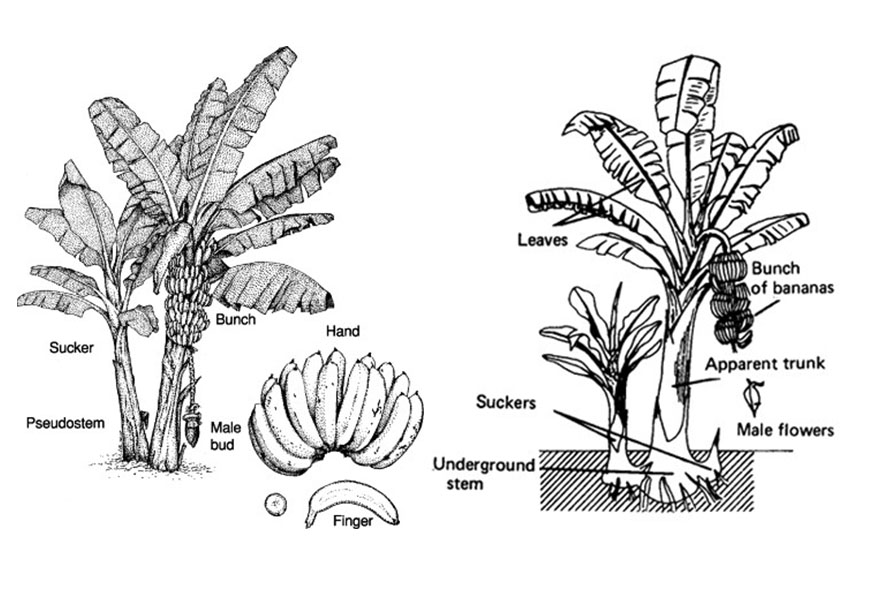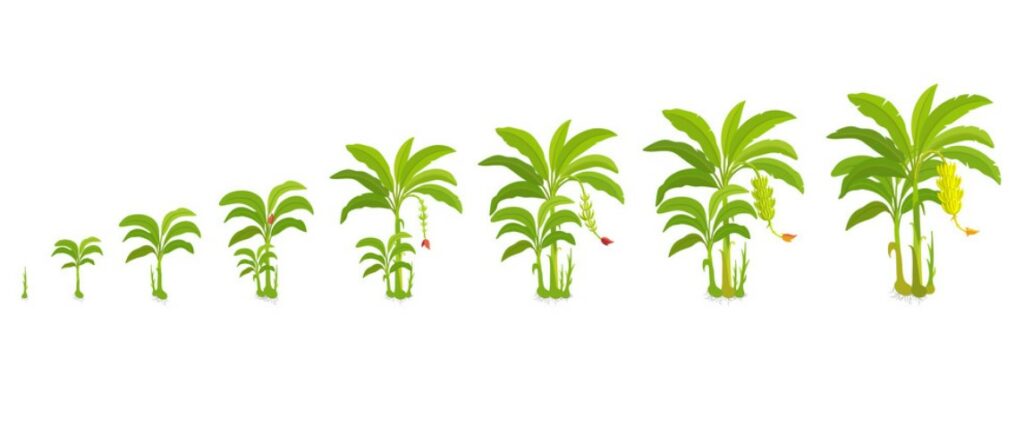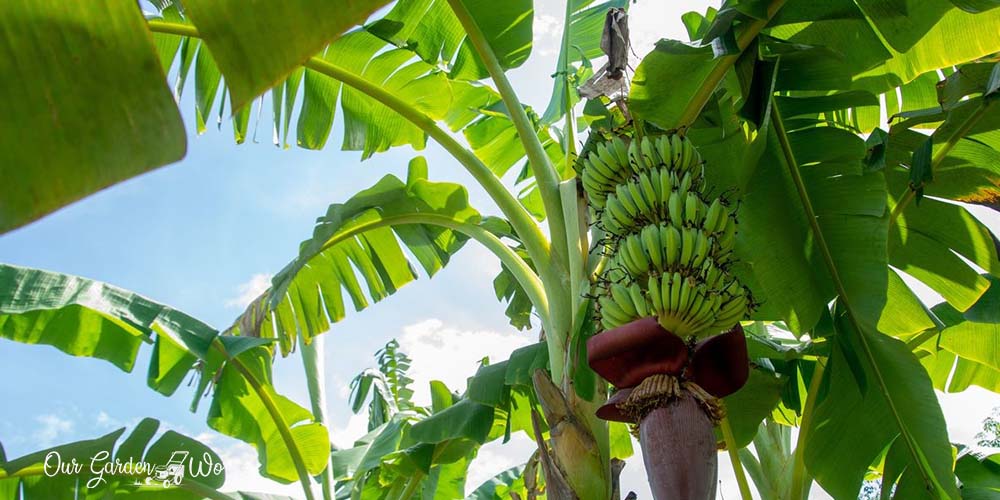Everybody loves the sweet taste of bananas. They are nutritious and filling, and as a gardener, you might be thinking of growing your banana trees in your yard.
Bananas are rarely grown in the US. However, some gardeners in Hawaii, Florida, California, Arizona, and Louisiana had a lot of success in banana production due to their warm climates.
In this post, learn how fast banana trees grow and the care they need for you to have them in your yard.
We will also share how you can grow them in your yard if your climate is compatible with their needs.
Q: How Fast Do Banana Trees Grow?
Banana trees grow up to their optimal height within 8 to 12 months. Their variety is the basis for identifying how tall they can grow.
According to We Be Bananas, a local grower of bananas in San Diego, California, banana trees can grow from 6 feet for dwarf banana trees to 25 feet for tall banana trees.
As the banana trees mature, it takes 12 to 16 months to produce flowers and fruits. However, the timeline varies depending on the variety of bananas.
After one cycle of fruition, the life of banana trees ends. Gardeners cut the banana trees to make way for new growth on their stumps. As you navigate the world of banana trees, you must know that they’re not trees. Learn more about bananas, how they are different, and the care they need so you can grow them in your yard.
Everything You Need To Know About Bananas
Banana is a big perennial herb that grows underground through rhizomes or corms. Rhizomes like tulip bulbs grow horizontally where the buds grow on the nodes. Each bud grows as a pseudostem which is the trunk-like structure we see above the ground. The pseudostem is a bunch of leaf stems that you can see clearly when the whole tree is cut.
The roots of bananas are shallow so it’s common for them to bend or uproot when the crown is too heavy or the pseudostem becomes weak. If the trunk diameter of a banana tree is high then it is sturdy enough to stand. Narrow trunks of banana trees indicate that they may fall and may need some stakes or prop to stay upright.
Bananas are tropical plants that need a steady amount of sunlight throughout their life cycle. So, they only thrive in tropical locations like Hawaii where they cultivate a sweeter variety called apple bananas.
Though the US does not have the ideal climate for bananas, some varieties are successfully grown by most enthusiasts in some warm parts of the country. These include:
- African Rhinohorn
- Baccarii
- Balbisiana
- Basjoo
- Brazilian
- Burmese Blue
- Cardaba
- Dwarf Cavendish
- Dwarf Orinoco
- Dwarf Plantain
- Dwarf Red
- Double (Mahoi)
- Ensete Maurelii
- FHIA 01 (Goldfinger)
- FHIA 02 (Mona Lisa)
- FHIA 03 (Sweetheart)
- FHIA 17
- Williams
- FHIA 18
- Goldfinger (FHIA 01)
- Grand Nain
- Gros Michel
- Green Red
- HuaMoa
- Ice Cream (Blue Java)
- Kandrian
- Kru
- Lacatan
- Manzano
- Monkey Fingers
- Monthan
- Musella Lasiocarpa
- Mysore
- Namwa
- Nino
- “X” (Grand Nain) Sumatrana)
- Pelipita
- Pisang Raja
- Pitogo
- Praying Hand
- Raja Puri
- Red Tall
- Red Iholena
- Rose
- Saba
- SH 3640
- Textiles (Abaca)
- Thai Black (Black balbisiana)
- Thousand Fingers
- Truly Tiny
- Veinte Cohol
- White Iholena
- Yangambi KM-5
- Zebrina (Sumatrana)
Banana trees need a lot of water, nutrients and enjoy full sun exposure. Due to their shallow root system, they are best planted next to a wall that faces the east. The wind can bruise the leaves of bananas and can even pull them off the ground. So, a wall next to it is a good strategy to keep them upright.
Three types of bananas are the sweet ones that you buy from supermarkets, the not edible ornamentals, and plantains which are the starchy ones. The kind of bananas grown in Hawaii and other parts of the US are the yellow and sweet types of bananas.
Now, let’s move on with the banana jargon that you should know as a future grower.
Parts of a Banana Tree

Since banana trees are not your ordinary tree, some terms might be new to you like hands, suckers, and banana heart. Here is a quick review of the parts of a banana tree:
- Pseudostem: It is the trunk of the banana that comes from the bud growing from the nodes of the rhizomes underground. Though it looks like a trunk, it is a bunch of leaf stems. It is called the pseudostem since the real stem of the banana tree runs underground.
- Sucker: The daughter plants or the small banana trees that grow next to the mature banana plant. They are connected underground through the horizontal stem.
- Bunch: A bunch is the flower stem that holds several hands of bananas. Each bunch produces 15 hands.
- Male bud/flowers: Banana trees are self-pollinating herbs that don’t need cross-pollination to produce fruits. The female flowers are the one that grows into bananas and is attached externally to the flower stem. The male buds are hidden under the bracts of the banana heart.
- Banana heart or banana blossom: It is the flower of the banana tree that grows at the end of the last bunch of bananas. Aside from bananas, the banana heart is also edible and a nutritious substitute to fish.
- Hand: Each hand contains 15 to 20 bananas or fingers. It is attached to the flower stem and starts as small buds until the ovaries fertilize and form into full-grown sweet bananas.
- Finger: It is the term used for every piece of banana fruit. Every bunch produces around 200 fingers.
- Banana leaves: These are the big and broad leaves of the banana plant. It is delicate and easily torn apart when it’s windy. It also gets brown tips which indicate sunburn and dehydration.
- Underground stem and roots: The roots can reach up to 10 inches from the trunk of the banana tree. The real stem of the banana is growing horizontally underground which causes the growth of new trees next to it called suckers.
The Life Cycle of Banana Trees

Bananas are easy to grow as soon as you already have a sprouted seedling or a mother plant. Growing bananas from seeds may take around 2 weeks to a year to germinate. Buying a seedling would be more practical, time-wise.
The pseudostem grows and thickens around 3 to 6 months as the tree undergoes the vegetative stage. As the tree matures and has grown enough crown of leaves, the flowering stage starts.
A good indication that the flowering is emerging is when the trunk diameter of the banana tree has increased. The increase in trunk diameter means that the flower stalk is pushing upward in the pseudostem.
After three months of the flowering phase, the flower stalk is already out on top of the tree and develops female flowers which will soon become bananas. The fruiting phase usually takes another 3 months or more depending on the variety.
The flower stem will also develop the banana blossom at the bottom. As soon as the bunch of bananas is developed, you may remove the banana blossom to focus the energy of the tree on its fruits and make them sweeter. At this stage, you should also cover the bunch of bananas with plastic or any type of coverage to protect them from birds and other pests.
Contrary to popular belief, bananas are harvested when they are still green but already ripe. After a couple of weeks, you may start cutting the bunch of bananas and have it cleaned. They will turn into yellow and ripe bananas after a couple of days.
The banana tree will die after it produces fruits and will be cut in half, so the suckers next to it will absorb the water from its trunk. Then, slowly cut the rest of the trunk as it dries up. Then the suckers will replace it as the mother plant.
How many bunches can a banana tree produce?
A banana tree can only produce one bunch of bananas. After that, it will die and another tree emerges from the suckers.
Though one banana tree only lasts for one cycle, the rhizome below the ground will continuously provide suckers that grow into a full-grown banana tree.
Growing Requirements of Banana Trees
Banana trees can grow in well-draining soil enriched with compost. Though most of them thrive in warm climates, some varieties are cold-hardy and can thrive in cool climates.
It’s essential to learn more about the variety of bananas that you choose to plant to avoid having problems during the development of the fruits. Warm-season varieties may experience a slow-down in fruit production when it is in a cool climate. With that, the flower and fruit production may take longer than expected.
During the vegetative phase of their growth, banana trees need a lot of water and nutrients. You may need to water it daily and apply a 16-16-16 fertilizer every two weeks. Banana trees also need pruning every once in a while to help divert their energy to the flowering and fruiting phase.
Some varieties also produce a 100-pound banana bunch which will drag the tree down. To prevent the tree from falling, stakes and propping should be placed around the tree to support the weight of the banana bunch.
How To Grow a Banana Tree in Your Yard?
Learning how fast banana trees grow, you may want to try planting them yourself. Here’s a brief background on how you can get started:
- Soil preparation: To start planting a sucker or a banana seedling, mix a 1:1 ratio of soil and compost. You can also dig 1 shallow hole with 12 inches or more into the soil. Make sure to mix the compost-soil mix properly to achieve proper distribution of nutrients.
- Planting: Plant the banana seedlings 9.84 ft ( 3 meters) apart from each other to make way for their rhizomes underground. Make sure to water the newly planted seedling or sucker after planting them.
- Pruning: During the vegetative stage of the banana trees, you must prune out yellow and damaged leaves.
- Fertilization: Some gardeners use fertilizer mix with an NPK ratio with a high potassium content like 9-3-27. However, some gardeners already see good results in using 16-16-16 fertilizer. Avoid overfertilization as it causes tangled and bent banana leaves as they emerge from the pseudostem.
- Desuckering: To separate a sucker in a new location or divert the plant’s energy to the growing sucker. Good suckers that you can grow as your new banana tree are the ones that grow upright with sword-like leaves. Bad suckers are those that grow on the base of the mother banana tree.
- Pest and disease control: Fusarium wilt is a notorious fungal disease in banana trees that has caused a major economic loss among banana growers.
Tips in Growing Bananas
Here are some essential tips from banana growers for a successful harvest:
- You don’t need a specific NPK ratio of fertilizer for nourishing banana trees. A well-balanced fertilizer would be enough like 10-10-10 or 16-16-16.
- Don’t neglect pest and fungal control to ensure healthy banana trees and a good harvest.
- Pruning is a must to help preserve the energy of the banana trees and divert it to the production of flowers and fruits.
- Check the variety of bananas that you will plant to estimate and prepare yourself for the weight of its bunch. Some banana varieties produce big and chunky fingers which can drag down the whole tree. Prepare your prop or stakes if you choose a big variety of bananas.
Final Thoughts
We hope that this post has helped you learn how fast banana trees grow and everything you need to know about growing your bananas. They are easy to grow but require patience to taste their sweet fruits.
Let us know in the comments about your pursuit of growing your banana trees in your yard and your region.
Also, please don’t forget to share this post with your friends to set their expectations for growing bananas in their region and climate.
